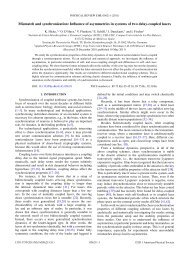DBI Analysis of Open String Bound States on Non-compact D-branes
DBI Analysis of Open String Bound States on Non-compact D-branes
DBI Analysis of Open String Bound States on Non-compact D-branes
You also want an ePaper? Increase the reach of your titles
YUMPU automatically turns print PDFs into web optimized ePapers that Google loves.
CHAPTER 3. SUPERSTRINGS 423.3.1 Closed stringsWe start by c<strong>on</strong>sidering the possibility thatψ + (σ, τ) = ±ψ + (σ + π, τ), (3.16)ψ − (σ, τ) = ±ψ − (σ + π, τ). (3.17)Note that these suppositi<strong>on</strong>s imply that the same relati<strong>on</strong>s also apply to the variati<strong>on</strong>sδψ ± . Furthermore, we see that if the + sign is chosen, the functi<strong>on</strong>s are periodic andare said to obey Ram<strong>on</strong>d boundary c<strong>on</strong>diti<strong>on</strong>s (R), if − is chosen they are antiperiodicand obey Neveu-Schwarz boundary c<strong>on</strong>diti<strong>on</strong>s (NS). ψ + corresp<strong>on</strong>ds to left-movers, ψ −to right-movers, and the periodicity c<strong>on</strong>diti<strong>on</strong> for them can be chosen independantly,resulting in four different possible combinati<strong>on</strong>s, namely, choosing to write them as(left-movers,right-movers), (NS,NS), (NS,R), (R,NS) and (R,R).To realize these different boundary c<strong>on</strong>diti<strong>on</strong>s, the following expansi<strong>on</strong>s can be applied:3 R left-movers: ψ + (σ, τ) = ∑ m∈˜dµ m e −2im(τ+σ) , (3.18)R right-movers: ψ − (σ, τ) = ∑ n∈d µ ne −2in(τ−σ) , (3.19)NS left-movers:ψ + (σ, τ) = ∑˜bµ r e −2ir(τ+σ) , (3.20)NS right-movers:r∈+ 1 2ψ − (σ, τ) = ∑b µ se −2is(τ−σ) . (3.21)s∈+ 12We see that the (anti)periodicity is reflected in the (half-)integer summing indices. Fromhere<strong>on</strong>, we will follow the c<strong>on</strong>venti<strong>on</strong> <str<strong>on</strong>g>of</str<strong>on</strong>g> using indices (m, n) for integer numbers, and(r, s) for half-integer numbers.3.3.2 <str<strong>on</strong>g>Open</str<strong>on</strong>g> stringsWhen c<strong>on</strong>sidering open strings, the names Ram<strong>on</strong>d and Neveu-Schwarz boundary c<strong>on</strong>diti<strong>on</strong>sare still used, but they corresp<strong>on</strong>d to different c<strong>on</strong>diti<strong>on</strong>s. Nevertheless, they arevery similar, explaining the double usage.Since now the positi<strong>on</strong>s (σ = 0) and (σ = π) corresp<strong>on</strong>d to two different and a prioriunrelated positi<strong>on</strong>s <strong>on</strong> the string, the two terms in Eq. 3.15 should vanish seperately.Hence, we see that{ψ − (0, τ)δψ − (0, τ) − ψ + (0, τ)δψ + (0, τ) = 0,(3.22)ψ − (π, τ) δψ − (π, τ) − ψ + (π, τ)δψ + (π, τ) = 0.3 Almost every reference uses b and d to denote the NS and R modes respectively, except for [14] whouse b for both, and differentiate <strong>on</strong>ly by means <str<strong>on</strong>g>of</str<strong>on</strong>g> their indices (m, n) or (r, s).
















